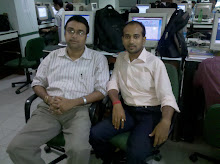Distributed Partition
views are used to access data that has been horizontally splits or partitioned across
multiple tables. Table objects can be located in different database or even separated
across multiple servers.
We combine
table by partition view by using UNION ALL statements that causes data on separate
table to appear as if they were on one table.
There are
several restrictions to create this views mentioned bellow.
1. All
the columns of the members table should be included in the views.
2. The
columns are in same ordinal positions in the SELECT statement and have the same
data type.
3. The
same columns cannot be used multiple times.
4. The
partition columns cannot be computed, identity, or a time stamp columns.
5. The
data value of the partition columns cannot be overlap in the underlying table.
6. The
partition columns must be the members of the primary key of the members table.
7. Members
table of the partition views need CHECK constraint of the partition columns.
8. There
is no index of computed columns of the members table.
9. The
primary key columns of the members table should have the same.
10. The entire member table should have
the same ANSI PADDING.
If you are
creating a distributed partitioned view, each member table is on a separate
member server. For the greatest location transparency, the name of the member
databases should be the same on each member server, although this is not a
requirement.
Adding
linked server definitions on each member server containing the connection
information needed to execute distributed queries on the other member servers.
This gives a distributed partitioned view access to data on the other servers.
For
example, you are partitioning a Customer table into three tables. The CHECK
constraint for these tables is:
-- On Server1:
CREATE TABLE Tabl-A
(CustomerID INT PRIMARY KEY CHECK (CustomerID BETWEEN 1
AND 32999),
... -- Additional column definitions)
-- On Server2:
CREATE TABLE Tabl-B
(CustomerID
INTE PRIMARY KEY
CHECK (CustomerID
BETWEEN 33000 AND
65999),
... -- Additional column definitions)
-- On Server3:
CREATE TABLE Tabl-C
(CustomerID INT PRIMARY KEY CHECK (CustomerID BETWEEN
66000 AND 99999),
... -- Additional column
definitions)
To create distributed
partitioned views for the preceding example, you must:
1. Add a linked-server definition named Server2 with
the connection information for
Server2, and a linked server
definition named Server3 for access to Server3
2. Create this distributed partitioned view:
CREATE VIEW
Customers
AS
SELECT * FROM CompanyDatabase.TableOwner.Tabl-A
UNION ALL
SELECT * FROM Server2.CompanyDatabase.TableOwner.Tabl-B
UNION ALL
SELECT * FROM Server3.CompanyDatabase.TableOwner.Tabl-C
3. Perform the same steps on Server2 and Server3.
3. Perform the same steps on Server2 and Server3.
Updating Distributed Partition View
If a local or
distributed partitioned view is not updatable, it can serve only as a read-only
copy of the original table. An updatable partitioned view can exhibit all the
capabilities of the original table.
A view is considered
an updatable partitioned view if:
The view is a set of
SELECT statements whose individual result sets are combined into one using the
UNION ALL statement. Each individual SELECT statement references one SQL Server
base table. The table can be either a local table or a linked table referenced
using a four-part name, the OPENROWSET function, or the OPENDATASOURCE function.
The view will not be updatable if a trigger or cascading update or delete is
defined on one or more member tables.
Hope you like that.
Posted by: MR.
JOYDEEP DAS




No comments:
Post a Comment